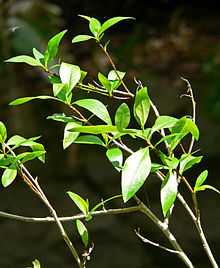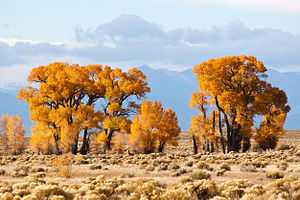Populus angustifolia
From Wikipedia, the free encyclopedia
| Populus angustifolia | |
|---|---|
 | |
| Scientific classification | |
| Kingdom: | Plantae |
| (unranked): | Angiosperms |
| (unranked): | Eudicots |
| (unranked): | Rosids |
| Order: | Malpighiales |
| Family: | Salicaceae |
| Genus: | Populus |
| Section: | Tacamahaca |
| Species: | P. angustifolia |
| Binomial name | |
| Populus angustifolia James[1][2][3] | |
 | |
| Natural range of Populus angustifolia | |
Populus angustifolia is a species of poplar tree known by the common names Narrowleaf Cottonwood and Willow-leaved Poplar. This tree is native to the Great Basin in the United States where it is most often found by streams and creeks at some elevation.
The tree is slim in profile, with yellow-green lanceolate (lance-shaped) leaves with scalloped margins. The catkins are fluffy and white. The buds are sticky and gummy and were enjoyed as a sort of chewing gum by local Native American peoples, including the Apache and Navajo.
The tree is the host species of the sugarbeet root aphid (Pemphigus betae)
-

Narrowleaf Cottonwoods in the fall
References
External links
This article is issued from Wikipedia. The text is available under the Creative Commons Attribution/Share Alike; additional terms may apply for the media files.